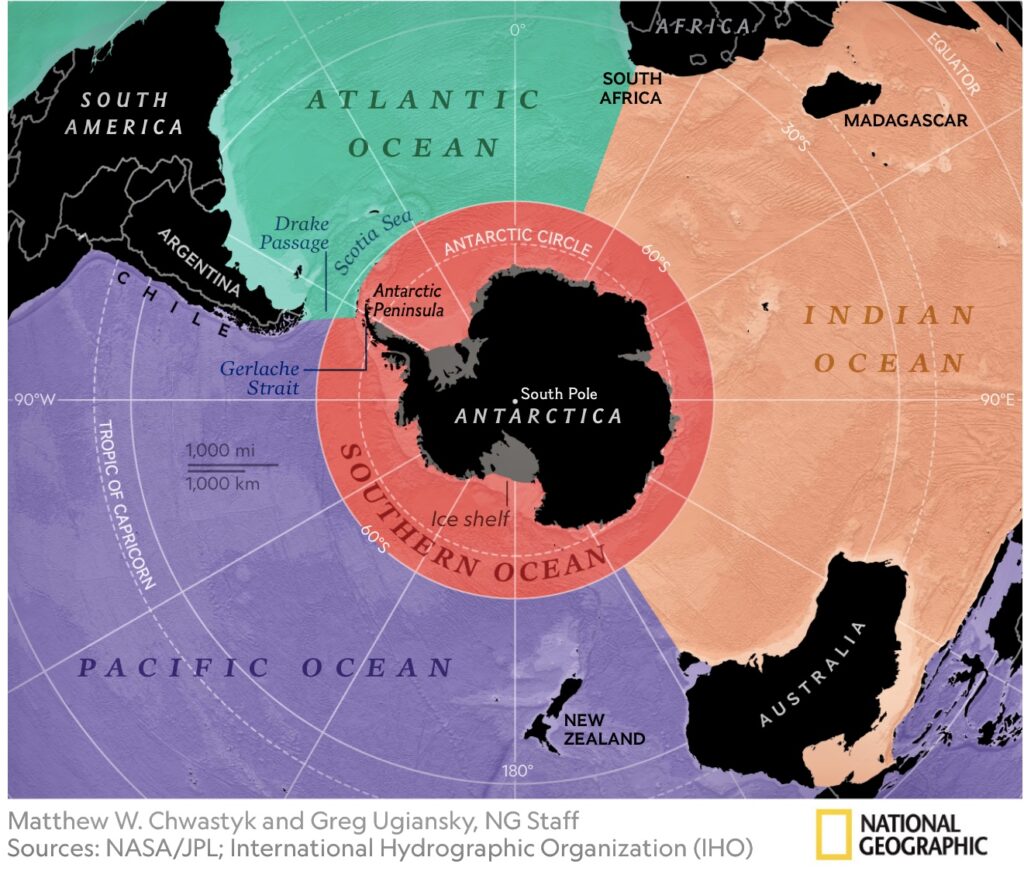Text by Henrylito D. Tacio
Photos: National Geographic
The permanent thing in this world is change, so goes a popular saying. This can be applied in anything – even in science.
“Science is not the truth,” someone said. “Science is finding the truth. When science changes its opinion, it doesn’t lie to you. It learned more.”
Such is the case of the oceans. Most people know the four oceans, namely: the Pacific (the largest and deepest of Earth’s oceanic divisions), Atlantic (the second-largest, covering approximately 20% of Earth’s surface), Indian (third largest covering 19.8% of the water), and Arctic (the smallest, the shallowest and the coldest).
Now, there’s a new one – and it’s officially called the Southern Ocean.
“The Earth has finally attained popular recognition for its fifth ocean, with a decision by the National Geographic Society to add the Southern Ocean around Antarctica to the four it recognizes already,” livescience.com’s Tom Metcalfe wrote.
Actually, the ocean is nothing new.
“Although the designation of the frigid waters around the icy southern continent as a separate ocean has kicked around for almost 100 years and is widely used by scientists, until now it has not had popular backing,” penned Metcalfe, a London-based journalist who writes mainly about science, space, archaeology, the earth, and the oceans.
During the World Oceans Day celebration last June 8, the US-based National Geographic Society announced it would henceforth be labeling the Southern Ocean as the fifth ocean on its maps of the planet.
“The Southern Ocean has long been recognized by scientists, but because there was never agreement internationally, we never officially recognized it,” the society’s official geographer Alex Tait told the National Geographic website. “It’s sort of geographic nerdiness in some ways.”
Tait said that one of the biggest impacts would be on education.
“Students learn information about the ocean world through what oceans you’re studying. If you don’t include the Southern Ocean, then you don’t learn the specifics of it and how important it is,” he said.
Borders and names for oceans and seas were internationally agreed when the International Hydrographic Bureau convened the First International Conference on July 24, 1919. The International Hydrographic Organization (IHO) came into existence and published these in its Limits of Oceans and Seas (1928).
In the 1928 edition, the Southern Ocean was delineated by land-based limits: Antarctica to the south, and South America, Africa, Australia, and Broughton Island, New Zealand to the north.
In the 1937 delineation, the northern limits of the Southern Ocean were moved southwards. In 1953, Southern Ocean was omitted from the official publication and left to local hydrographic offices to determine their own limits.
When National Geographic began making maps in 1915, the society had only formally recognized just four oceans. But it cannot be denied that the Southern Ocean was formed when Antarctica and South America moved apart, opening the Drake Passage roughly 30 million years ago, according to Wikipedia.
The separation of the continents allowed the formation of the Antarctic Circumpolar Current (ACC), which allows water to flow unimpeded around the “bottom” of the world.
“One reason for considering it as a separate ocean stems from the fact that much of the water of the Southern Ocean differs from the water in the other oceans,” Wikipedia explains. “Water gets transported around the Southern Ocean fairly rapidly because of the ACC, which circulates around Antarctica.

“Water in the Southern Ocean south of, for example, New Zealand, resembles the water in the Southern Ocean south of South America more closely than it resembles the water in the Pacific Ocean,” Wikipedia adds.
Thousands of marine species live only within the ACC, according to National Geographic.
“There are relatively few fish species in a few families in the Southern Ocean,” Wikipedia claims. “The most species-rich family are the snailfish, followed by the cod icefish, and eelpout.”
Five species of krill, small free-swimming crustaceans, have been found in the Southern Ocean. Slow-moving sea spiders are common, sometimes growing as large as a human hand.
Like the other oceans, the Southern Ocean is not spared from the consequences of climate change. “The Southern Ocean is one of the regions in which rapid climate change is most visibly taking place,” Wikipedia reports. “In this region, small perturbations in temperature lead to major environmental perturbation.”
Sub-divisions of oceans are geographical features such as “seas,” “straits,” “bays,” “channels,” and “gulfs.” Among the biggest seas in the Southern Ocean are Weddell Sea, Somov Sea, Lazarev Sea, Scotia Sea, Ross Sea, Mawson Sea, Amundsen Sea, and the Davis Sea.
Actually, “Southern Ocean” is an obsolete name for the Pacific Ocean or South Pacific, coined by Vasco Nuñez de Balboa, the first European to discover it, who approached it from the north.
The “South Seas” is a less archaic synonym, Wikipedia states. A 1745 British Act of Parliament established a prize for discovering a Northwest Passage to “the Western and Southern Ocean of America.”
According to National Geographic, the U.S. Board on Geographic Names has used the name the Southern Ocean since 1999. In February this year, the National Oceanic and Atmospheric Administration (NOAA) officially recognized the Southern Ocean as distinct.

